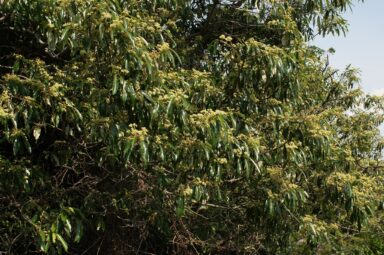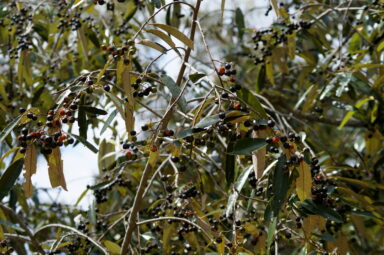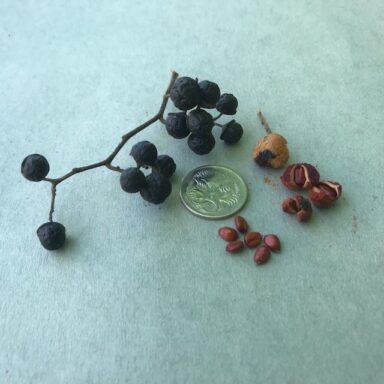Alphitonia excelsa, commonly known as Soap tree or Red Ash, is a medium to large evergreen tree native to eastern Australia.
It is a versatile and resilient tree with significant ecological, cultural, and practical value.
Taxonomy:
- Family: Rhamnaceae
- Genus: Alphitonia
Description:
- Growth: Tree 10-25 meters in height with rough, dark bark that flakes irregularly.
- Leaves: Glossy, lanceolate leaves with silvery undersides
- Flowers: Small, creamy white flowers in clusters from late winter to early spring
- Seed: Small, dark blue or black drupe about 1 cm in diameter.
Habitat and Distribution:
Red Ash thrives in various habitats, from coastal forests to dry woodlands, across eastern Australia. It prefers well-drained soils and can tolerate different soil types.
Hosts: (included but not limited to)
- White-headed Pigeon (Columba leucomela): Feeds on the fruits, aiding in seed dispersal, crucial for the propagation of the tree. May also use the dense foliage for nesting and protection from predators.
- Lewin’s Honeyeater (Meliphaga lewinii): Feeds on the nectar of the flowers, helping pollinate the flowers, contributing to the tree’s reproductive cycle. The tree provides a suitable environment for nesting and shelter.
- Australian King-Parrot (Alisterus scapularis): The fruits form part of the diet of Australian King-Parrots, aiding in seed dispersal. These parrots use the tree for roosting and nesting, benefiting from the protection offered by the dense foliage.
- Common Crow (Euploea core): The larvae feed on the leaves, this feeding does not usually harm the tree significantly and contributes to the lifecycle of the butterfly.
- Southern Leaf-tailed Gecko (Phyllurus platurus): Ese the rough bark and foliage as habitat. The tree provides an ideal environment for hunting insects and avoiding predators.
- Golden Orb-Weaver (Nephila plumipes): Build their webs in the foliage, using the tree’s structure to catch prey. These spiders feed on insects that visit the tree, contributing to the control of insect populations.
Ecology and Uses:
- Soap: Indigenous Australians have long utilized the bark of Alphitonia excelsa, which contains saponins, as a natural soap.
- Erosion Control: With its extensive root system, Alphitonia excelsa helps stabilize soil and prevent erosion.
- Medicinal: The leaves and bark were used in traditional medicine to treat various ailments.
- Timber: The hard, durable wood is suitable for construction and furniture.
- Landscaping: Its resilience and attractive appearance make it popular in gardens and public spaces.
Links:
Alphitonia excelsa : Red Ash | Atlas of Living Australia (ala.org.au)





